-
Happy Birthday ICMag! Been 20 years since Gypsy Nirvana created the forum! We are celebrating with a 4/20 Giveaway and by launching a new Patreon tier called "420club". You can read more here.
-
Important notice: ICMag's T.O.U. has been updated. Please review it here. For your convenience, it is also available in the main forum menu, under 'Quick Links"!
You are using an out of date browser. It may not display this or other websites correctly.
You should upgrade or use an alternative browser.
You should upgrade or use an alternative browser.
How to passively cool 15 watts of LEDs?
- Thread starter angelgoob
- Start date
Phychotron
Member
The best option is to use copper, Its what the passive CPU coolers that I've seen are made of. I plan on making my own LED's in the future and want to invest in copper heat sinks, as they are completely reusable. I could just upgrade the diodes and power supply as new technology comes out. I'm sure the price of copper will go up in the future so I could even recycle it and maybe even make money off it. Same with aluminum, but copper has better cooling properties.
Otherwise check the wattage on CPU's that are going with CPU coolers and get one that is much larger capacity. Many new CPU's are over 100w, so 15w passive should be fine.
Check ebay for cheap new and used CPU coolers, they even sell cob-LED's with heat sink's built on them for pretty cheap..
Otherwise check the wattage on CPU's that are going with CPU coolers and get one that is much larger capacity. Many new CPU's are over 100w, so 15w passive should be fine.
Check ebay for cheap new and used CPU coolers, they even sell cob-LED's with heat sink's built on them for pretty cheap..
Thumbnail of 18 each .06 watt diodes making 1.1 watts on a passive cooled bar. Lots of little diodes spread the heat better than one large diode at 1 watt and a hundred of them make up a 4' bar.
That means a 300 watt triple bar (second thumbnail) uses almost 5000 diodes. My mind boogles but so far all of them work flawlessly (thumbnails 3 and 4).
I just wanted an excuse to publish the photos.
I also run some 150 watt sets at 50 watts per bar, both the 100 and the 50 watt bars run 25 watts per foot and in still air are too hot to hold onto for more than a second.
Roughly 160 degrees for 25 watts going into an aluminum heat sink 3" across and a foot long with 15 each 1/2" fins running lengthwise.
Putting an actual 15 watts into a CPU heatsink will make the temperature over that of boiling water even with a fan. It would need to be water cooled for that much wattage.
Confusing rated wattage with actual wattage causes major discrepancies. A 45 watt screw in LED grow bulb (15 each 3 watt diodes) when tested with a watt meter put out 7.5 watts, a full 6 times less than the rated 45 watts.
Passive cooling is not efficient and at grow room temperatures fans blowing on the fins is required, unless running under 10 watts.
A sealed container with fan forced air traveling directly through massive copper/aluminum heat sinks is the answer higher energy LED manufacturers came up with.
Passive cooling is for lower energies used by low height row crops, lettuce is a common example.
These low energy (25 watts/foot) LED bars are a step up from T5's and are good clone lights and side lights, even vegging, but for budding they are still inadequate.
A 14 watt GE LED (replacement for 100 watt incandescent) residential bulb runs quite hot and is heavy due to the huge heat sink required. The warning not to use in enclosed fixtures is prominent. The ceiling of a grow room is usually hotter than the maximum recommended.
Heat is the number one cause of death among LEDs.
I also run Philip's far red LED flowering lamps. These are 13 watt screw in LED bulbs designed for greenhouse use with long night commercial flowers. Each one of them is more than twice the weight of the same wattage residential LEDs and so far have run just fine. A thumbnail of one of them. This is only 13 watts and weighs in at over a pound.
That means a 300 watt triple bar (second thumbnail) uses almost 5000 diodes. My mind boogles but so far all of them work flawlessly (thumbnails 3 and 4).
I just wanted an excuse to publish the photos.
I also run some 150 watt sets at 50 watts per bar, both the 100 and the 50 watt bars run 25 watts per foot and in still air are too hot to hold onto for more than a second.
Roughly 160 degrees for 25 watts going into an aluminum heat sink 3" across and a foot long with 15 each 1/2" fins running lengthwise.
Putting an actual 15 watts into a CPU heatsink will make the temperature over that of boiling water even with a fan. It would need to be water cooled for that much wattage.
Confusing rated wattage with actual wattage causes major discrepancies. A 45 watt screw in LED grow bulb (15 each 3 watt diodes) when tested with a watt meter put out 7.5 watts, a full 6 times less than the rated 45 watts.
Passive cooling is not efficient and at grow room temperatures fans blowing on the fins is required, unless running under 10 watts.
A sealed container with fan forced air traveling directly through massive copper/aluminum heat sinks is the answer higher energy LED manufacturers came up with.
Passive cooling is for lower energies used by low height row crops, lettuce is a common example.
These low energy (25 watts/foot) LED bars are a step up from T5's and are good clone lights and side lights, even vegging, but for budding they are still inadequate.
A 14 watt GE LED (replacement for 100 watt incandescent) residential bulb runs quite hot and is heavy due to the huge heat sink required. The warning not to use in enclosed fixtures is prominent. The ceiling of a grow room is usually hotter than the maximum recommended.
Heat is the number one cause of death among LEDs.
I also run Philip's far red LED flowering lamps. These are 13 watt screw in LED bulbs designed for greenhouse use with long night commercial flowers. Each one of them is more than twice the weight of the same wattage residential LEDs and so far have run just fine. A thumbnail of one of them. This is only 13 watts and weighs in at over a pound.
Attachments
-
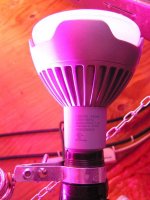 730 nm Far Red bulb, all plants in the garden get FR at dusk and dawn.jpg51.8 KB · Views: 15
730 nm Far Red bulb, all plants in the garden get FR at dusk and dawn.jpg51.8 KB · Views: 15 -
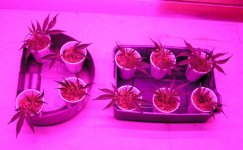 Veg.jpg47.7 KB · Views: 12
Veg.jpg47.7 KB · Views: 12 -
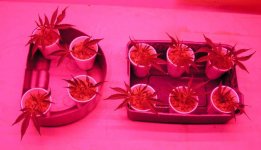 Flower.jpg40.4 KB · Views: 14
Flower.jpg40.4 KB · Views: 14 -
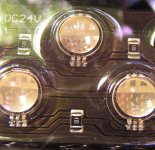 Part of a 300 watt unit each emitter is 18 each .06 watt diodes.jpg100.5 KB · Views: 24
Part of a 300 watt unit each emitter is 18 each .06 watt diodes.jpg100.5 KB · Views: 24 -
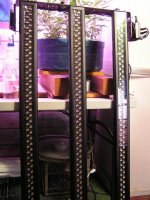 LED frame is four foot by two foot.jpg79.5 KB · Views: 16
LED frame is four foot by two foot.jpg79.5 KB · Views: 16
15 watt but some is converted to light.....
I doubt it would reach boiling temps.
I guess adding a 1.5 watt fan per 15 watt unti isn't that much off a loss and increased cooling makes the LED put out more light.
And yes a fan cooled regular cpu heatsink wouldn't even come close to overheating.
I doubt it would reach boiling temps.
I guess adding a 1.5 watt fan per 15 watt unti isn't that much off a loss and increased cooling makes the LED put out more light.
And yes a fan cooled regular cpu heatsink wouldn't even come close to overheating.
Latest posts
-
-
-
-
-
Sativas, Breeding long flowering racy Equitorials:
- Latest: IndicaFarmer
Latest posts
-
-
-
-
-
Sativas, Breeding long flowering racy Equitorials:
- Latest: IndicaFarmer


